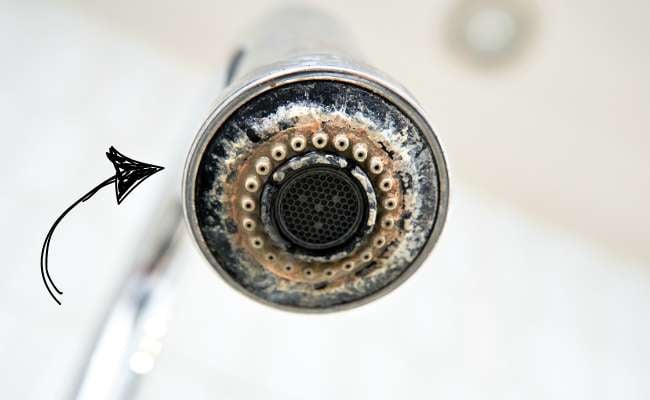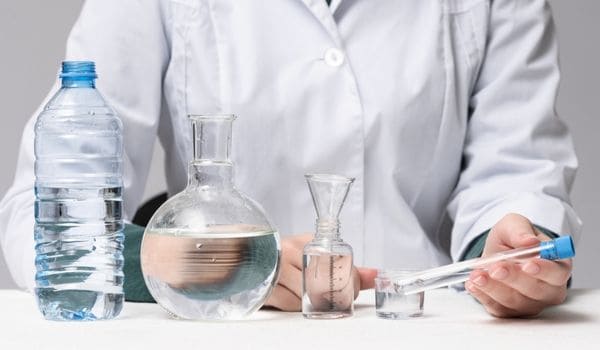Limescale can be a silent nuisance in homes with hard water. It builds up slowly on your fixtures and appliances, often mistaken for stubborn soap scum. But it’s not a cleaning issue — it’s a water quality issue. Understanding what causes it is the first step to fixing it for good.
💡 Key Takeaways:
- Limescale is a chalky deposit that forms when hard water dries and leaves behind calcium and magnesium.
- You’ll usually find it on taps, showerheads, and inside water-using appliances like dishwashers and washing machines.
- Over time, limescale can clog pipes, reduce water flow, wear down your appliances, and even drive up your energy bills.
- Natural solutions like vinegar or lemon juice — and store-bought descalers — work well for removal.
- A water softener is your best defense against limescale, treating the problem at its source.
💧 What Causes Limescale Buildup?

Limescale is the chalky, white residue that appears when hard water evaporates and leaves minerals behind — mostly calcium and magnesium. These minerals don’t just disappear — they cling to surfaces like sinks, shower doors, and appliances.
Hot water speeds this up. That’s why you’ll spot limescale most in places like bathroom fixtures, kettles, and dishwashers — anywhere heat and water meet.
🚫 Common Problems Caused by Limescale
Limescale doesn’t just look bad — it can mess with your plumbing, appliances, and even your skin. Here’s what it can cause:
- Higher Energy Bills: When your appliances lose efficiency, they draw more power — and that adds up.
- Stubborn Stains: It builds up on taps, showerheads, and glass, leaving crusty white marks that regular cleaners won’t touch.
- Low Water Pressure: Limescale narrows pipes and clogs faucet aerators, making water trickle instead of flow.
- Skin Irritation: Hard water minerals can dry out your skin and leave behind soap residue.
- Dull, Frizzy Hair: Mineral buildup weakens hair and strips away shine, making it harder to manage.
- Appliance Damage: Coffee makers, water heaters, and dishwashers work harder and wear out faster when scale coats their inner parts.
💧 Limescale Removal Made Easy

Limescale buildup can feel impossible to tackle — but with the right tools and a few simple techniques, you can restore your fixtures and appliances without harsh chemicals. Whether you’re dealing with chalky faucets or a stubborn toilet bowl ring, here’s a breakdown of the most effective ways to remove limescale from every corner of your home.
| 🔍 Where | 🧪 What You Need | 🧼 Steps |
|---|---|---|
| Taps & Faucets | White vinegar or lemon juice, warm water, cloth, elastic band | Soak cloth in 1:1 vinegar/water, wrap around tap, let sit for hours, wipe and rinse |
| Shower Walls & Glass | Dish soap, vinegar or citric acid, spray bottle, sponge | Spray mixture on surface, wait 15 mins, scrub and rinse clean |
| Showerheads | Lemon half, toothbrush, vinegar (optional) | Rub with lemon, let sit 10 mins, scrub. For buildup, soak in vinegar-water |
| Toilet Bowls | Vinegar, baking soda, toilet brush | Pour vinegar & soda in bowl, let sit 1 hour, scrub. Use paste for tough stains |
| Coffee Makers & Kettles | Vinegar, water, sponge | Boil vinegar-water in kettle. For coffee maker, run cycle, then rinse |
| Pipes & Drains | White vinegar, boiling water | Pour vinegar, wait, flush with boiling water. Repeat if needed |
🧽 Final Tip: Most limescale removal comes down to patience and letting mild acids do the work. If you stay on top of buildup with weekly cleaning, you’ll spend less time scrubbing and more time enjoying spotless sinks, clear shower doors, and appliances that actually work like they should.
🚫 How to Prevent Limescale Buildup (Without Losing Your Mind)

Scrubbing limescale once it forms is no picnic — so why not stop it at the source? Prevention is easier than you think. With a few small changes and one smart investment, you can keep your pipes, fixtures, and appliances running clean and smooth.
🧹 Regular Cleaning
Staying ahead of buildup is key. Limescale forms fast in homes with hard water, so wipe down wet surfaces (especially after hot showers), clean appliances monthly, and run descaling cycles as needed. It’s basic, but it works.
💧 Install a Water Softener or Conditioner
Hard water is the root of the problem. If your home has high levels of calcium and magnesium, consider one of these options:
| 🛠️ Type | ✅ How It Works | 🔄 Maintenance |
|---|---|---|
| Salt-Based Water Softener | Removes calcium and magnesium ions through ion exchange | Needs salt refills and occasional cleaning |
| Salt-Free Water Conditioner | Alters calcium structure using Template Assisted Crystallization (TAC) to prevent sticking | Minimal maintenance, no salt or waste |
📌 Note: Only salt-based softeners truly “soften” the water. Conditioners reduce scale but don’t change how hard water feels on skin or hair. That said, they’re eco-friendly, nearly maintenance-free, and reduce limescale by up to 90%.
🧪 Confirming Hard Water: Why Testing Still Matters

The signs of limescale are usually obvious, but cleaning habits and fixture finishes can minimize its appearance. Meanwhile, it collects in your pipes, and the next thing you know — you’re spending your vacation fund on a new water heater.
The only way to know with certainty if you have a limescale problem is to test your water for hard minerals. It’s so easy that anyone can do it.
🔍 How to Test for Hard Water
If you’re on city water, your supplier can usually tell you if your water is considered hard or soft. But if you use a well, it’s on you to test.
Two simple options:
- 💧 Test Strips: Just dip a strip into your tap water and compare the color change to the included chart. It’s a fast and affordable way to screen for hardness, though not as accurate as lab testing.
- 🧪 Lab Testing: For a detailed breakdown of mineral levels and other contaminants, go with a certified lab. We recommend SimpleLab’s Tap Score kits — they offer testing options for both city and well water.
💡 Tip: If you’re using well water, the CDC recommends testing annually for hardness, pH, total dissolved solids, and bacteria.
Final Thoughts
Limescale is more than an ugly nuisance. Given time, it can have a serious impact on your home. So, clean it for looks — but prevent it to save.
 141 people found this helpful. Was this guide helpful to you?
141 people found this helpful. Was this guide helpful to you? 

